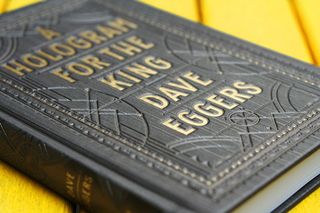OPINION: Why real book covers still resonate
Printed book covers will always trump digital, argues Jeremy Garner, executive creative director of Weapon7.
As more and more people move towards buying ebooks instead of the tangible kind, there's a growing sense of an expanding disconnect between the two. That is, rather than being alternative manifestations of the same creative work, it's almost like they're completely different products.
Call me a die-hard, old-school book-browser, but there's something interesting in the dichotomy of 'real' book covers continue to explore ways of capturing not only the premise, theme, characterization or main events of a story but its tone and aesthetic landscape too, the Kindle (I'm purposefully not including the Kindle Fire in my reasoning, as it's a tablet) only offers (currently anyway) basic black and white 'covers'.
Creative canvas
Of course there's a valid argument that many people would have already seen what book they will buy from Amazon in the 'real world' first. What I'm talking about here is the limited creative canvas offered by Kindle in the way of hooking the interest of the reader via rich cover art in the same way that 'real' books are so good at.
Even if you're the type of person who chooses never to visit bookshops any more, I challenge you not to walk into one, look at the new releases and refrain from picking up the ones that jump out and catch your eye. (Just so you can see what more your senses can tell you about what more the book may promise in the way of design, illustration, textures, choice of stock and printing techniques.)
Let's have a quick glance around the shelves of recent new releases, and how the covers encapsulate the contents.

'A Hologram for the King' by Dave Eggers, a story about a struggling businessman in a rising Saudi Arabian city - which explores the metaphor of fading away in terms of both the protagonist and a "weary, recession-scarred America" - would seem to capture not only the themes of the novel but the nuances of the writing.
As GQ Magazine puts it, "The American version - ornately embossed and inlaid with gold by Detroit printer Thomson-Shore - is one of the most beautifully printed novels you'll ever see. It's the kind of print craftsmanship usually reserved for cookery books and holy texts. It's the kind of book bookshelves are made for, and one that the Kindle, for all its benefits, could never do justice."

The newly-designed 1984, too, is incredibly satisfying, albeit on a far simpler level, when inspected for real, meriting frequent glances whilst reading, thanks to the succinct boiling-down of the idea of the Ministry of Truth rewriting history. But, could the cover ever work electronically, even if there are those who would claim the design is nothing more than a cleverly-orchestrated PR stunt?
Richly evocative
The list goes on. The exquisite, Goya-inspired illustration on the cover of Pure by Andrew Miller seems to perfectly capture the 1785 Parisian setting and, as one reviewer says, the fact that the book is "detailed, symbolic and richly evocative of a time, place and man in dangerous flux. It is brilliance distilled, with very few impurities."
Then there are cookery books. I mean, have you ever salivated over the text of a recipe on a Kindle? It's the richness of the visuals, coupled with the tactile feeling of the book that brings the recipes to life.
Emotive context
Of course, there are people who would counter that the lack of visual richness offered by Kindle as its very strength. The simple greyscale backgrounds which underpin the lettering ensure that, visually, nothing ever gets in the way of what’s most important: the story. And shouldn't that be what it's all about?
Well, yes. But if books are essentially products - whether printed-page varieties or ebooks - then shouldn’t they deserve an emotive context, a wrapper to reach out and intrigue, to resonate, to whisper (or shout) the first few words of the story?
Tech has the answer
I believe technology will eventually provide an answer. After all, the market for books will always be a highly competitive one, and novels need to convey their points of differentiation just like any other product.
For now, people will just have to continue to browse in their local bookshop for emotive stimulus whenever they can't but resist but to judge a book by its cover. Even if they don’t admit it.
Words: Jeremy Garner
Jeremy Garner is executive creative director of Weapon7. He was previous the co-founder of two pioneering digital agencies in London (Glue and BloodPartnership), vice president of creative at Modem Media and creative director at LBi London. He has been a jury member at the D&AD, Clio Interactive, London International and Cresta awards.
Liked this? Read these!
- Illustrator tutorials: amazing ideas to try today!
- Great examples of doodle art
- The ultimate guide to designing the best logos
Are you still wedded to print, or are you all about the ebook these days? Share your views in the comments below!

Thank you for reading 5 articles this month* Join now for unlimited access
Enjoy your first month for just £1 / $1 / €1
*Read 5 free articles per month without a subscription

Join now for unlimited access
Try first month for just £1 / $1 / €1
Get the Creative Bloq Newsletter
Daily design news, reviews, how-tos and more, as picked by the editors.
The Creative Bloq team is made up of a group of design fans, and has changed and evolved since Creative Bloq began back in 2012. The current website team consists of eight full-time members of staff: Editor Georgia Coggan, Deputy Editor Rosie Hilder, Ecommerce Editor Beren Neale, Senior News Editor Daniel Piper, Editor, Digital Art and 3D Ian Dean, Tech Reviews Editor Erlingur Einarsson and Ecommerce Writer Beth Nicholls and Staff Writer Natalie Fear, as well as a roster of freelancers from around the world. The 3D World and ImagineFX magazine teams also pitch in, ensuring that content from 3D World and ImagineFX is represented on Creative Bloq.
